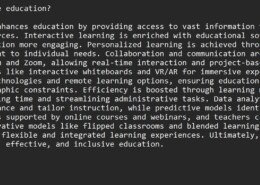Technology has the potential to significantly transform teaching by enhancing accessibility, engagement, and efficiency in education. With tools like interactive whiteboards, digital textbooks, and online resources, teachers can create dynamic and engaging learning environments that cater to variousRead more
Technology has the potential to significantly transform teaching by enhancing accessibility, engagement, and efficiency in education. With tools like interactive whiteboards, digital textbooks, and online resources, teachers can create dynamic and engaging learning environments that cater to various learning styles. For instance, interactive simulations and educational games can make complex subjects like math and science more understandable and enjoyable for students.
Moreover, technology enables personalized learning experiences through adaptive learning platforms that adjust content based on individual student performance. This personalized approach helps in addressing the unique needs of each student, ensuring that no one is left behind. Additionally, online learning platforms and MOOCs (Massive Open Online Courses) provide access to high-quality education regardless of geographical location, making education more inclusive.
Communication and collaboration are also enhanced through technology. Tools such as video conferencing, online discussion forums, and collaborative software allow for real-time interaction between teachers and students, as well as among students themselves. This can foster a more interactive and supportive learning community.
Furthermore, technology streamlines administrative tasks, giving teachers more time to focus on teaching. Automated grading systems, digital attendance, and cloud-based storage for lesson plans and student records improve efficiency and reduce the administrative burden on educators.
See less

Sustainable farming practices can greatly improve soil health and increase crop yields by focusing on long-term environmental health and productivity. Here’s how: 1. Soil Enrichment: Practices like crop rotation and cover cropping help maintain soil fertility. Different plants contribute different nRead more
Sustainable farming practices can greatly improve soil health and increase crop yields by focusing on long-term environmental health and productivity. Here’s how:
1. Soil Enrichment: Practices like crop rotation and cover cropping help maintain soil fertility. Different plants contribute different nutrients to the soil, and cover crops protect the soil from erosion and add organic matter when they decompose.
2. Reduced Chemical Use: Sustainable farming often involves reducing the use of synthetic fertilizers and pesticides. Instead, organic fertilizers like compost or manure enrich the soil naturally. This approach avoids the buildup of harmful chemicals and helps maintain a balanced soil ecosystem.
3. Conservation Tillage: By minimizing tillage, or plowing, farmers can prevent soil erosion and preserve its structure. This practice helps retain moisture and nutrients, leading to healthier soil.
4. Water Management: Techniques such as drip irrigation deliver water directly to plant roots, which conserves water and reduces soil erosion. This efficient use of water supports better plant growth and higher yields.
Overall, sustainable farming practices focus on nurturing the soil and using resources efficiently, leading to improved soil health and increased crop productivity over time.
See less